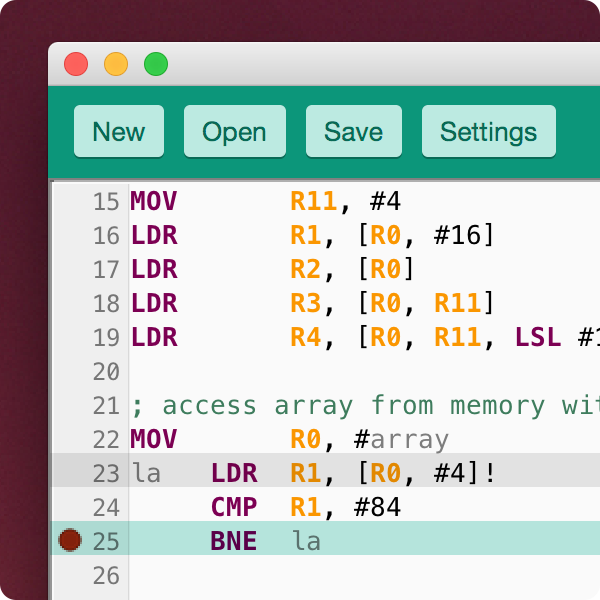
- #Loop with a highly visual arm emulator how to
- #Loop with a highly visual arm emulator manual
- #Loop with a highly visual arm emulator full
- #Loop with a highly visual arm emulator code
Mnemonics for the operations the processor is capable of,
#Loop with a highly visual arm emulator code
Instructions and the actual machine code and assembly uses There is a one-to-one relationship between the assembly If you want more ARM/THUMB guides, you'll have to find them yourself.Īssembly is little more than a glorified macro language for machineĬode.

(note: minor syntax discrepancies at times)
#Loop with a highly visual arm emulator manual
The rather large official ARM7DTMI Technical manual (PDF): This chapter is not an island, I am assuming you have

#Loop with a highly visual arm emulator how to
Or at least know how to make use of the various reference documents With that information, you should be able to do a lot of stuff, Lastly, I'll give an example of a fast memory copier asĪn illustration of both ARM and Thumb code. I'll also cover how to use GCC's assembler to actuallyĪssemble the code and how to make your assembly and C files work What you can and cannot do with them (and a little bit about The most important instructions of the ARM and THUMB instruction sets, My intention here is to give youĪn introduction (but a thorough one) to ARM assembly. This would require an entire book in itself, which
#Loop with a highly visual arm emulator full
Loop styles, operator precedence, etc – it's one line, one opcodeĪnd never more than a handful of parameters.Ī complete document on assembly is nothing less than a full user's The simplicity of the statements themselves have anĪesthetic quality as well: no messing about with classes, different Higher languages should appeal to your inner geek, who relishes The description of the processor itself, knowledge of assembly willĪ third reason, and not an inconsiderable one, is just for Is 32bit, it will prefer ints for most things, and other types willīe slower, sometimes much slower. Understand how the CPU functions, and you can use that Speed/size issues aside, there are other reasons why learningĪssembly might be a good idea. Is exactly what makes fast code possible. It's anarchy, but the lack of bureaucracy Goto no structs or classes with inheritance, and evenĭatatypes are mostly absent. There are no structuredįor- or while- loops or even if/else branches, just On a compiler or interpreter to do it for you. To program in assembly, you need to know how a processorĪctually works and write in a way it can understand, rather than rely So yeah, it is harder and more dangerous. May have, so that it's much easier to break things. You're bypassing all the safety features that higher languages

The CPU, you can make it do everything but that also means you Now, in some circles the word “assembly” can be used Sometimes you really have to make every cycle count. ‘portable assembly’, because it still has the capability Most GBA work is done in C/C++, sometimes affectionately nicknamed Languages will cost you dearly, if it'd run at all. The GBA, with its 16.7Mhz CPU and less than 1 MB There are still a few instances where the higher languages are Thing: code can be written faster and maintained more easily. For PCs, these days are long gone and most work isĭone in the higher level languages. Machine code or assembly because of clock speed and/or memoryĬonstraints. Old days, programmers were Real Programmers and did their work in

Portability, at the cost of runtime speed and program size. Interpreters configured to run the right kinds of machine codeĮvery step up the ladder increases the human readability factor and Languages like PHP (and usually VB and Java) which are run through Language element to read more like English, but need to be compiled This is essentially machine code in words: eachĪssembly instruction corresponds to one machine code instruction.Ībove this are compiled languages like C, which use structured The CPU decodes into instructions to execute. At the lowest level is machine code: raw numbers that Very broadly speaking, you can divide programming languages intoĤ classes.


 0 kommentar(er)
0 kommentar(er)
